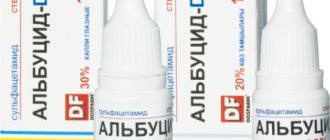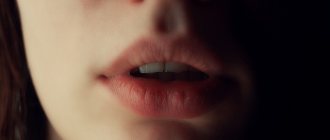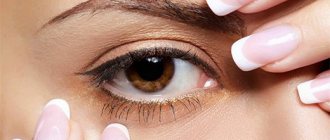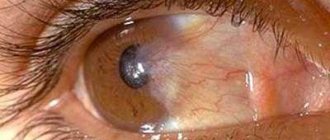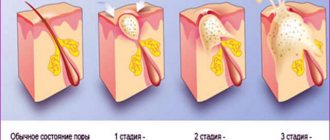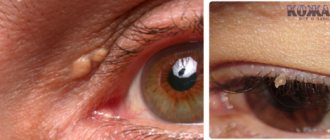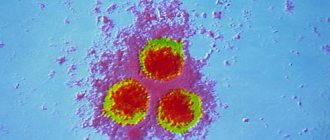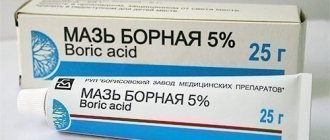A feature of barley is its abrupt onset and active development. Barley is almost always accompanied by unpleasant sensations for a person, so you want to get rid of it as quickly as possible. How long does stye last on the eye? This depends on how quickly the appropriate treatment was provided and what remedies were used.
Description of the disease
A purulent tumor not only affects the appearance, but also causes a lot of inconvenience - pain, burning, itching. What is this disease? And is it a pathology?
Barley is the result of an inflammatory process that develops in the hair “bag” of the eyelash. The development of an abscess can be caused by inflammation of the sebaceous or meibomian gland. But the latter variant of the development of the disease is less common in medical practice.
Barley can appear on both the lower and upper eyelids. And as soon as an unpleasant burning sensation begins and an inflamed tumor appears on the eye, it is necessary to begin treatment immediately. How many days the stye will go away depends on the timeliness of the therapy used.
Symptoms
You will feel pain around the eye, and then the area will become red, swollen, and tender. Then a pimple pops up here. It itself is small, and the eye or both are swollen. Often we feel itching and we rub our eyes. If you look in the mirror, you will notice that the eyelid is swollen. To make a pimple ripen faster, you need to heat it.
Does it affect vision?
No. Does not affect vision in any way. The eyeball will not become infected.
What causes stye?
Its occurrence is provoked by staphylococcus bacteria. They live in the nose and easily get into the eyes. You rub your nose, and then automatically rub your eye, so you have infected yourself.
Causes
The development of barley often occurs due to bacterial infection. A pathogenic bacterium enters the eye, which causes inflammation.
Factors that provoke the appearance of barley include:
- weak immunity;
- weakness of the body after suffering a serious illness or surgery;
- hypothermia;
- deficiency or, conversely, excess of fortified substances in the body;
- failure to observe basic personal hygiene (touching eyes with dirty hands, etc.);
- use of low-quality or expired cosmetics (mascara, pencil or eye shadow);
- getting dust or dirt into your eyes (staying in a very dusty room);
- diseases (furunculosis, diabetes mellitus, pathologies of the endocrine system, diseases of the digestive organs);
- infectious diseases of the eyelids (demodex, blepharitis, conjunctivitis);
- anemia;
- physical fatigue;
- nervous disorders;
- genetic predisposition.
Styes can “pop out” in adults or children.
Causes of stye on the eye
Staphylococci, which prefer to settle on human skin and hair, do not manifest themselves in any way with strong immunity. Their intensive reproduction is triggered by a decrease in the protective properties of the body, its hypothermia, severe illnesses and hypovitaminosis, and the consequences of helminthic infestation. Penetrating into the structure of the hair follicle, streptococci cause inflammation and suppuration as a reaction to a pathogenic microorganism. This is the main cause of stye on the eye in patients of all ages. With an unbalanced diet, increased physical activity or stressful situations, the disease can occur in the form of several or multiple suppurations on the eyelids or mucous membranes. Also among the factors contributing to the appearance of stye on the eye is the habit of touching the eyelids with dirty hands, a large amount of dust indoors or outdoors.
The risk group for the likelihood of the appearance of barley includes:
- patients with reduced immunity;
- persons with diseases of the endocrine system;
- patients with gastrointestinal pathologies;
- persons whose professional activities involve working outdoors or in premises with difficult climatic or unsanitary conditions;
- patients who have suffered inflammatory diseases of the eyes and eyelids, as well as those who have not completed the prescribed course of treatment.
Characteristic symptoms
Most often, the formation of an abscess begins with a slight burning sensation and slight redness in the eyelid area. Soon other symptoms join the early signs:
- itching in the area of the sore spot;
- minor pain and increasing discomfort;
- redness and swelling of the eyelid;
- the formation of a purulent “ball”, which increases in size until the moment of “breakthrough” (barley ripens in 2-4 days, after this time the abscess opens);
- minor headaches;
- increase in body temperature (37-38 degrees);
- fever, chills;
- enlargement of lymph nodes located near the site of inflammation.
Traditional medicine recipes
The painful syndrome of barley and the external effect can be easily and quickly removed, for example, with the help of tea leaves, but remember that the disease that provoked the barley must be treated in a clinic by a doctor. Pharmacies sell ointments and drops that fight infection, relieve swelling, and help quickly cure stye. But they can only be used as prescribed by a doctor. Inexpensive remedies from the arsenal of traditional medicine will help you on your own.
Egg
The egg is the most famous means of quickly treating inflammation, the dry heat of which promotes faster maturation and release of pus.
- Preparation: Boil the egg until cooked.
- Application: wrap the egg in a scarf and apply it warm to the inflammation.
Potato
Potatoes are also used to make dry warming compresses in the treatment of barley.
- Preparation: boil the potatoes until tender, mash with a fork.
- Application: wrap the potato mass with a napkin or handkerchief and apply it to the inflammation on the eye.
Salt
Salt serves as a quick treatment for inflammation.
- Preparation: heat the salt in a frying pan, pour it into a bag made of thick fabric.
- Application: apply the bag to the inflammation and hold until it cools.
Flax seed
Flax seeds are also used to warm an inflamed eyelid.
- Preparation: add flaxseed to a frying pan and heat it.
- Application: pour the heated seed onto a scarf, tie it in a knot and apply it to the sore spot.
Aloe
Aloe is a well-known folk healer that successfully fights inflammation.
- Preparation: grind a medium-sized aloe leaf, leave for 8 hours in a glass of boiled, chilled water. Strain the tincture.
- Application: use the resulting product to make lotions and wipe the eyelid.
Calendula
Calendula is a plant that has an anti-inflammatory effect.
- Preparation: pour a glass of boiling water into 3 tbsp. l. calendula flowers, leave for half an hour.
- Application: moisten cotton wool with the decoction and apply to the inflamed eyelid.
Herbal infusions
Herbs such as chamomile and eyebright can help quickly get rid of stye on the eye. Eyebright has a disinfecting effect, and chamomile reduces irritation and inflammation.
- Preparation: 2 tbsp. l. Pour 200 ml boiling water over eyebright and chamomile.
- Application: remove the steamed herb from the liquid, place it on a napkin and apply it to the eyelid.
Treatment method
If early pathological signs appear, you should urgently consult an ophthalmologist.
Treatment tactics are prescribed individually. The prescription of certain medications depends on the characteristics of the patient’s body, his age, the presence of concomitant diseases and the degree of complication.
What is included in the general treatment regimen for barley?
- Disinfection of the inflamed area of the eye. Treatment of the abscess is carried out with special solutions - brilliant green, iodine, 70% ethyl alcohol, calendula infusion. Primary treatment is carried out by an ophthalmologist. In the future, on the recommendation of a doctor, the procedure will need to be repeated at home. The frequency of eye disinfection is up to 5 times a day.
- Prescription of anti-inflammatory and antibacterial eye drops and ointments. Eye drops are instilled under the eyelid 2-4 times a day (the frequency of the procedure is prescribed by the doctor). The ointment is applied to the lower eyelid up to 3 times a day (as prescribed by a doctor).
Eye drops:
- Levomycetin;
- Hydrocortisone (1%);
- Prednisolone (0.3%);
- Gentamicin;
- Penicillin;
- Sulfapyridazine sodium (10%);
- Albucid (30%);
- Dexamethasone (0.1%);
- erythromycin (1%).
Ointments:
- tetracycline;
- yellow mercury (1%);
- hydrocortisone;
- erythromycin.
To prevent the development of a bacterial complication, the patient may be prescribed an antibacterial drug - Tobramycin.
Physiotherapy using UHF rays can be prescribed as an auxiliary therapy and in the form of a preventive measure.
Treatment of barley
And about. Minister of Health of Ukraine Ulyana Suprun shared tips on her Facebook page on how to properly treat stye. According to her, advice from the Internet, which is more like rituals and conspiracies, is ineffective.
“On the Internet you can find a lot of advice on how to “treat” it: rub it with a ring, spit in the eyes, show a fig, tie your fingers with thread, or even apply cow dung,” the official listed popular “methods” for treating barley. “There is no reason to believe that a stye will go away if you rub a ring on your eyes or go to a fortune teller.” Some may have the false impression that these are truly effective treatments. But in fact, barley does not go away thanks to their use. It just goes away on its own."
It is absolutely forbidden to spit in anyone's eyes - human saliva contains a wide variety of microorganisms, which, upon contact with the mucous membrane, can give the patient new diseases, and not only eye diseases.
If you have stye, Suprun advises:
- To reduce inflammation, apply a soft cloth moistened with warm water to the eye for 5-10 minutes. This procedure can be repeated 3-4 times a day.
- To reduce pain, you can take ibuprofen or paracetamol.
- You should not wear contact lenses or make up your eyes until the stye goes away.
- Under no circumstances try to get rid of it mechanically on your own. This can lead to infection.
In other words, you should wait until the abscess breaks through. The main thing is not to squeeze out the pus or try to open the abscess, otherwise the infection from it can enter the blood and spread throughout the entire eyelid. And you should stick your hands into your eyes as little as possible, and women should not use cosmetics during this period.
According to Ulyana Suprun, barley will go away on its own within a week, maximum two. However, you should consult a doctor if:
- the eyelid is very swollen and hurts,
- vision begins to deteriorate,
- the inflammation does not go away for 3 weeks.
The doctor may prescribe antibacterial drops and anti-inflammatory drugs. In some cases, surgery may be necessary to get rid of stye. Its essence is to open the purulent cavity, clean it, and treat it with antibiotics.
Family doctor and teacher at the Academy of Family Medicine of the Association of Family Doctors of Kazakhstan, Elena Khegai, also recommended that when barley appears, make warm compresses and under no circumstances squeeze it out.
- In most cases, barley goes away on its own; using antibiotic drops is not recommended, this only increases the risk of bacteria resistant to antibiotics appearing when their use is absolutely necessary. To relieve symptoms, I recommended the patient to apply dry warm compresses to the area of inflammation (this could be either a clean handkerchief heated with an iron or a boiled egg wrapped in it). The main thing is to make sure that the compress is not hot, otherwise you may get burned. Heat should be applied as often as possible, but for at least 15 minutes 4 times a day. Under no circumstances should you “squeeze out” the stye; it should open on its own. If in the morning your eyelids are “glued together” with dried mucus, you can wipe your eyes with clean cotton swabs soaked in boiled water - from the periphery to the center. As a rule, barley goes away within 3-5 days without complications. If during this time it does not get better, or inflammation progresses, body temperature rises, or general health worsens, then it is necessary to return to the doctor to determine further treatment tactics, she noted.
Traditional therapy
You cannot use the recipes of traditional healers as the main method of treating barley. But they can be used to speed up the healing process and maturation of the abscess.
Before using folk remedies, it is important to consult an ophthalmologist. Often traditional therapy is harmful and causes the development of serious complications.
Recipes
The following methods will help the abscess to mature:
- Boil a chicken egg. Wrap it warm in a clean handkerchief and apply it to the inflamed area. The duration of therapy is 5-7 minutes. It is important to use this method only in the early stages of stye formation, that is, when itching and burning appear in the eye area. If an abscess forms, any thermal procedures are prohibited.
- In a similar way, you can use boiled potatoes, which must be mashed with a fork before placing in a handkerchief.
- Prepare a decoction of calendula (can be replaced with chamomile). Cool the composition to a moderately warm state and rinse the inflamed eye thoroughly. It is recommended to repeat the procedure up to 4-5 times a day.
- A popular way to combat various ophthalmological problems is to wash the sore eye with brewed black tea. The procedure must be repeated three times a day, each time using freshly brewed tea.
- Dilute aloe juice with boiled water (1:1 ratio). Strain the resulting mixture. Soak a piece of gauze in the solution and apply it to the inflamed eye for a couple of minutes. Then moisten a clean piece of gauze in the same solution and apply it again to the inflamed eye. Repeat the procedure three times a day.
- Tansy decoction is intended for internal use. To prepare the solution, you need to brew 1 tbsp. a spoonful of tansy flowers in a glass of boiling water. Infuse, strain. Divide the resulting portion into 3 parts and take at equal intervals throughout the day. Tansy decoction increases the body's defenses, directing the immune system to fight inflammation. Taking a decoction promotes faster recovery and getting rid of barley.
If, when using any of the recipes, the pathological symptoms intensify, then further treatment should be stopped immediately and consult an ophthalmologist.
With internal barley, folk recipes are powerless. In this case, only drug treatment prescribed by a doctor is used.
Types and stages of development of barley
Depending on the location and external signs there are:
- External stye is a painful formation on the eyelash line that quickly festeres. Signs of barley in this case are visible to the naked eye, which simplifies the diagnosis;
- internal barley - localized inside the eyelid, causing discomfort due to severe pain and the feeling of a foreign object in the eye. It is detected during a visual medical examination.
The formation and development of barley occurs in several stages:
- infiltration process. The first characteristic signs of suppuration appear: itching, swelling, redness of the eyelid in the area of inflammation. Over the course of several hours, the discomfort intensifies;
- process of suppuration. A capsule with purulent contents is visible on the surface of the formation. With an increase in the volume of pus or mechanical impact, it may break out prematurely;
- the process of breakthrough of the purulent capsule. If the inflammation does not break out on its own, it is opened by a surgeon. Separation of purulent contents occurs within several days;
- healing. A crust forms at the site of the ulcer, under which a thin layer of restored skin forms. Depending on the quality of the course of treatment and the state of the immune system, the healing period can range from several days to several weeks.
Complications of stye on the eye
The importance of seeing a doctor when barley appears is due to the high risk of developing the following complications:
- conjunctivitis is an infectious lesion of the mucous membrane of the eye, causing swelling, hyperemia and some blurring of vision. Treatment of the disease is complex and lengthy;
- Chalazion is a cystic formation on the inside of the eyelid. Causes inconvenience and requires long-term treatment;
- phlegmon of the orbit - caused by profuse suppuration due to an attempt to independently open the stye or multiple formation of foci of suppuration with their subsequent fusion. Symptoms of this pathology are blurred vision, severe swelling, discomfort when moving the eyelid, etc.;
- thrombosis of the vascular plexus - a violation of the outflow of fluid from the orbit, which causes swelling. The eyeball protrudes, the skin turns blue, the eyelids become inflamed, and vision deteriorates sharply;
- thrombophlebitis is an inflammatory process in blood vessels. Characterized by headache, feeling of fatigue, decreased visual acuity, redness of the eye mucosa;
- meningitis - consequences of phlegmon of the eye. Signs of a deadly pathology: temperature above 39°C and severe headache;
- sepsis is blood poisoning due to the ingress of pus and pathogenic microorganisms into it. Signs of complications: intoxication of the body, chills, rapid heartbeat, rash, breathing problems.
What will help speed up recovery?
In combination with medication and folk therapy, it will be useful to reconsider your lifestyle. Some changes in behavior or diet will help speed up the maturation of the abscess and its subsequent opening.
- Do not touch your eyes with dirty hands. Try to “disturb” the sore eye as little as possible.
- Revise the menu. Include more fortified foods in your diet (fermented milk dishes, vegetables, fruits), which help strengthen the immune system and help cope with pathological problems at a natural level.
Folk remedies
Medicinal herbs contain practically no substances that can destroy Staphylococcus aureus. The use of wet compresses or lotions with infusions of marigolds, chamomile, and string is ineffective even at the initial stage of the pathology. And the lack of sterility can cause the development of conjunctivitis. Such infusions and decoctions should be taken orally during therapy, replacing coffee or strong tea with them. They boost immunity, helping to speed up recovery. This method cannot be used to treat any type of stye during pregnancy. During pregnancy, oral use of infusions is strictly prohibited.
The most effective folk remedies that help treat stye at home quickly and effectively include dry heating. During the procedure the following are used:
- boiled chicken egg wrapped in cloth;
- a linen bag filled with flax seeds or coarse sea salt.
What can delay recovery?
Many people, completely ignorant of medicine, begin to use independent treatment. Methods of barley therapy such as “spitting in the eye” or “tying the abscess with black thread” often provoke the development of complications, which negatively affects the duration of recovery.
If the patient’s disease proceeds without complications, then the stye will go away in 3-5 days. If the patient used the wrong treatment tactics, recovery may take several weeks.
The most common mistakes when treating stye are:
- applying a wet compress to the sore eye;
- gluing barley with plasters;
- thermal effects (warming barley, using warming compresses);
- use of inhalations based on medicinal herbs or essential oils;
- use of cosmetics during the therapeutic process;
- Constantly scratching the sore eye.
Main symptoms
Late signs and symptoms appear after the abscess appears. All initial symptoms intensify several times. Redness can affect not only the eyelid, but also the skin around the eye. The stye grows to the size of a barley grain, fills with pus, and has a purulent top. Sometimes stye covers part of the eye, preventing you from blinking, seeing clearly, or completely closing your eyelids.
After 3-5 days after the first symptoms appeared, a thin film appears on the top of the barley, under which a point with cloudy or whitish contents appears. In some cases, the film is replaced by a dense crust. This moment is the most difficult for the patient. I just want to squeeze out the annoying pimple. But this is strictly forbidden, because the stye is not yet ripe, and squeezing it out will lead to the spread of infection to the eye structures, and the stye will take much longer to heal, and perhaps more similar neoplasms will appear next to it. In this case, the disease will become chronic and treatment will take more than a month. It’s better to wait a couple of days and let the sore ripen than to suffer for a long time.
The symptoms of a stye are very similar to a boil, especially when it matures and has a purulent top. If it appears in the outer corner of the eye, severe swelling occurs due to impaired lymph outflow. The pathological process is accompanied by redness of the skin and conjunctiva. The redness increases as the abscess matures. When it begins to ripen and a dense top forms, the barley begins to resemble a mature grain of barley.
Barley is characterized by a limited localization. An abscess forms, inflammation and redness of the skin appears around it, which does not spread further. Barley has a dense, elastic consistency. If you press on it, you can see it twitch. There is pain next to it, which intensifies as the abscess matures and gradually gathers at one point.
Additional symptoms that patients with barley complain of are:
- headache;
- temperature increase;
- lethargy and weakness, general malaise;
- enlargement of the submandibular and preauricular lymph nodes.
Late symptoms of internal stye include the appearance of a small pinkish swelling that is painful to touch. If you bend the eyelid, a yellowish neoplasm similar to stye will be visible from the inside.
The appearance of external signs of barley greatly influence the psychological state of a person. Because of a red, swollen eye with a purulent pimple, the patient does not want to be in society, having a complex about his appearance.
After about 5-7 days, the neoplasm breaks through and its contents flow out, which is accompanied by significant relief of the patient’s condition.
In this case, external barley is safe, from which pus flows onto the skin of the eyelid. The contents of the internal sty leak into the conjunctival sac and can cause infection or infection of the eye and eyelids. In this case, it is better to play it safe and, after opening the internal abscess, rinse the eye with an antiseptic solution and drip antibacterial drops, for example Albucid.
Sometimes it happens that the tumor does not open for a long time. In this case, you need to contact an ophthalmologist who will open the abscess surgically. The same method of treatment can be resorted to if the barley is already ripe, but has not opened, and it greatly interferes with the person’s ability to open the eye and see normally.
After opening the abscess, swelling and redness subside, and redness of the eyelids can persist for a long time.
Symptoms
You can suspect the ripening of barley on the eye by the following signs:
- redness of the eyelid, eye shell,
- pain when blinking,
- burning, itching,
- swelling, swelling of the eyelid.
A small bump forms on the upper or lower eyelid, and when pressed, acute pain occurs. Later this formation is filled with purulent contents.
How long does it take before the abscess disappears? With proper treatment, the puss will resolve or open up after a few days, releasing a purulent mass.
Treatment options
A stye on the upper or lower eyelid usually lasts about a week. In order for the piss to go away faster, it is necessary to begin timely adequate therapy. Treatment of eye stye involves the use of the following medications:
- anti-inflammatory ointments: Tetracycline, Hydrocortisone,
- antibacterial eye drops: Albucid, Sofradex,
- antibiotics: Sulfalene, Sulfaethidol,
- antiseptics: ethyl alcohol, brilliant green.
In order to strengthen the immune system, vitamin and mineral complexes, immunomodulators, and dietary supplements are prescribed. How long does it take to treat the pathological process? If you start drug therapy from the first day of illness, the stye will go away within 3 days. You can cope with the problem in other ways:
- warming the abscess with a hot boiled egg wrapped in a rag, honey cake or salt in a bag,
- physiotherapy: infrared heating, UHF,
- exposure to cold (applying a cold metal fork or spoon to the eye),
- herbal lotions based on chamomile, calendula, aloe, plantain,
- applying tea bags and aloe leaves to the eye.
In advanced cases, when conservative therapy does not bring positive results, surgical intervention may be performed.
When treating stye on the eye, it is necessary to touch the abscess as little as possible and refrain from applying makeup.
Prevention of stye
Prevention of barley consists of observing the following measures:
- observe the rules of personal hygiene, wash your hands and face after going outside, do not touch your eyes with dirty fingers,
- strengthen the immune system,
- Healthy food,
- Avoid getting dust, foreign objects in your eyes,
- perform eye gymnastics,
- use high-quality, non-expired cosmetics, and avoid excessive application of makeup.
Styes do not last long and are often harmless, but it is still easier to prevent the disease than to treat it later.

